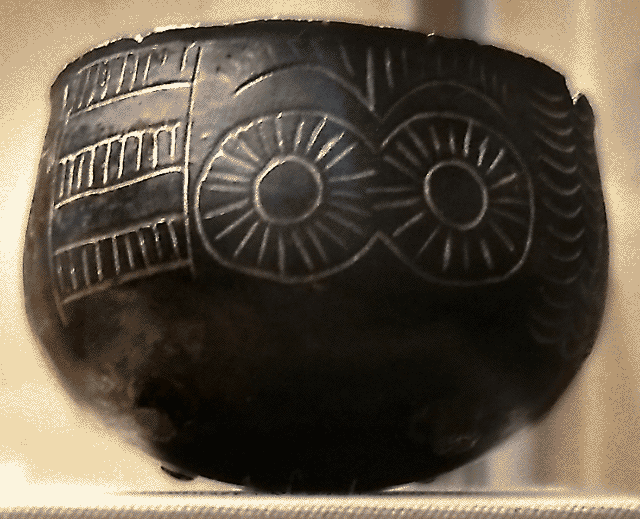This is less impacting than the recent spat of Paleolithic rock art datings but it is still interesting. Rock art from Cuenca province (Spain) of schematic style has been dated to the Chalcolithic period... as expected.
Why "as expected", because the motifs are very similar to others known from mobile art such as bone idols or pottery found in stratigraphic contexts in Southern Iberia in that same period. The so-called "oculados" (eyed) motifs are widespread.
However the range of possible dates obtained is wide: between the middle of the 4th millenium and the early 1st millennium BCE. It includes all the Chalcolithic but also the Bronze Age and even the beginnings of the Iron Age.
 |
| One of the dated sites |
 |
| Orange: areas of "oculado" idols in SW Iberia |
 |
| An "oculado" pot from Los Millares. |
It is often thought that the "oculados" represent some sort of deity of the age.
Sources[es]: Pileta, La Cerca.
Ref. Juan F. Ruiz et al. Calcium oxalate AMS 14C dating and chronology of post-Palaeolithic rock paintings in the Iberian Peninsula. Two dates from Abrigo de los Oculados (Henarejos, Cuenca, Spain). Journal of Archaeological Science 2012. Pay per view.
"It is often thought that the "oculados" represent some sort of deity of the age."
ReplyDeleteJust to consider an alternative other than the usual anthropological leap from images to religion, for the sake of argument, it could also be something in the same same vein as modern smiley face, Hello Kitty, Butterfly, or Unicorn iconography in middle school lunch boxes and t-shirts, or something like pink flamingos, gargoyles and lawn gnomes in 20th century suburbia - i.e. maybe Chalcolithic Iberians just thought it was cute.
Can you mention a Medieval or Antique example instead of a Late Modern one, so it becomes more likely?
DeleteThe closest I can think to that is when Colombus mentions the figurines made by the Tainos of Cuba and says they made it because they deemed it beautiful (apparently implying it was not religious).
Pink unicorns just doesn't ring the right bell, sorry.
Caryatids in late classical Greek, Roman and Renaissance settings were scupltures whose purpose was often as decorative as they were religious.
DeleteI think that there is a plausible case that lamassu, a human-headed winged lion from 883-859 BC in North Mesopotamia had a decorative rather than religious purpose. The rhyton (drinking horn) in the shape of a bull was found in Knossos from 1500-1450 BC is another plausible case of merely cute rather than religious iconography.
While a bit less sophisticated, the spiral designs on Cycladic pottery, and the characteristic embellishments of the older LBK and Cardial Pottery Neolithic pottery eras were also probably merely to make it pretty rather than for higher purposes (ditto South Asian painted gray ware from the late Bronze Age).
Representational Cycladic examples that are roughly contemporaneous and unlikely to be dieties include sculptures of musicians include a seated lyre player from 2000 BCE, and statues of a lute player and a harpist were found together in a single grave on Keros, dating from 2700 - 2750 BCE. Some of the art from 8th century CE Anglo-Saxon coins and the Brunswick Lion ca. 1166 CE also suggests desire to make decorative icons.
It could be something like that but what it's clear is that it had a special symbolism for the people who lived in an age and region so full of such icons.
DeleteAlso the eyes, in some cases in what seem to be stylized faces, in others on top, in place of the head of what seems to be a sticky-figure (schematic) body, are anomalous and to all us suggest the notion of a watcher, be it an owl or be it a spirit or deity. Similar notions can be seen in the Christian icon of their God as an eye in a triangle or in the Egyptian idea of the sun and the moon being the right and left eyes of Osiris, Horus or whatever. This latter idea I got from some the symbols, those of the Spanish part of the map, which can be compared to "twin suns" maybe.
But it could be of course just a symbol of an owl (very similar in many cases). But what did the owl mean to them? Was just an owl, a guardian spirit, the animal totem of a deity (maybe similar maybe totally different from the Greek Athena) or even the animal personification of a god, like among the Egyptians? Or maybe was not an owl at all...
We can't know anymore, sadly enough.
Must be an owl: look at this "Owl-shaped protocorinthian aryballos" from the 7th century BCE: it's identical to all those eyes, at least the ones from Spain.
DeleteBut I digress because the Cuenca icon actually looks anything but an owl. In fact to me it looks like a woman (stylized breasts to the sides) with a kid (much smaller in size), both with giant eyes instead of head.
Delete